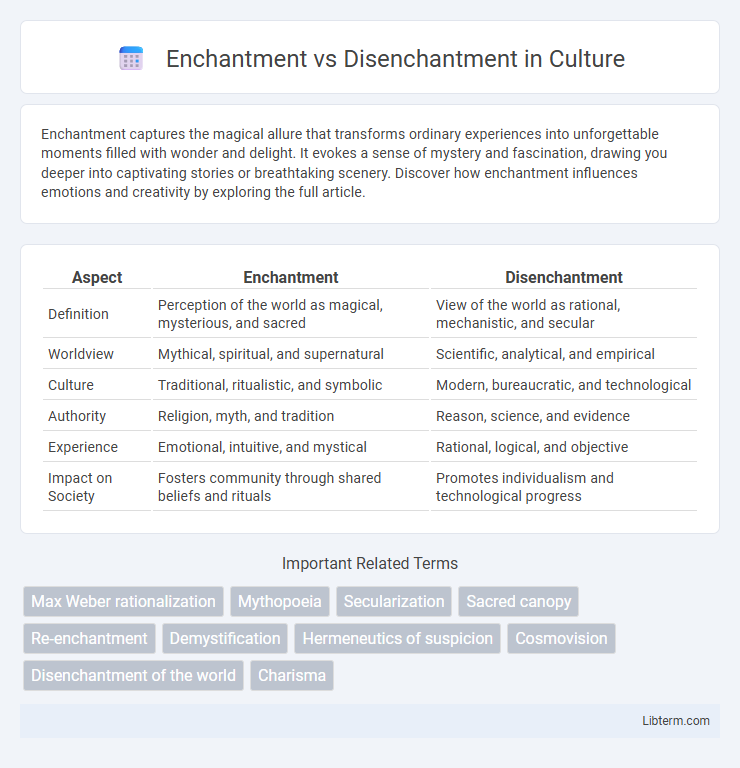Enchantment captures the magical allure that transforms ordinary experiences into unforgettable moments filled with wonder and delight. It evokes a sense of mystery and fascination, drawing you deeper into captivating stories or breathtaking scenery. Discover how enchantment influences emotions and creativity by exploring the full article.
Table of Comparison
| Aspect | Enchantment | Disenchantment |
|---|---|---|
| Definition | Perception of the world as magical, mysterious, and sacred | View of the world as rational, mechanistic, and secular |
| Worldview | Mythical, spiritual, and supernatural | Scientific, analytical, and empirical |
| Culture | Traditional, ritualistic, and symbolic | Modern, bureaucratic, and technological |
| Authority | Religion, myth, and tradition | Reason, science, and evidence |
| Experience | Emotional, intuitive, and mystical | Rational, logical, and objective |
| Impact on Society | Fosters community through shared beliefs and rituals | Promotes individualism and technological progress |
Understanding Enchantment and Disenchantment
Enchantment involves a deep sense of wonder, fascination, and connection to the world, often linked to cultural myths, rituals, and spirituality that imbue life with meaning beyond the mundane. Disenchantment refers to the rationalization and demystification of the world, characterized by science, logic, and secularization reducing the sense of mystery and magic in everyday experiences. Understanding these concepts reveals how societies shift from imaginative, symbolic interpretations of reality to empirical, utilitarian perspectives that prioritize control and predictability.
The Origins of Enchantment in Human Culture
The origins of enchantment in human culture trace back to early animistic beliefs where natural elements and spirits were thought to possess mystical powers, influencing daily life and survival. These foundational myths and rituals established a worldview rich in symbolic meaning and magical thinking, fostering a sense of wonder and connection to the environment. This cultural framework laid the groundwork for later religious and artistic expressions, embedding enchantment deeply into human consciousness.
Historical Shift: From Enchanted to Disenchanted World
The historical shift from enchantment to disenchantment marks a transition from a worldview imbued with magical and spiritual significance to one dominated by rationality and scientific explanation. This transformation began during the Enlightenment, as empirical methods and secular thinking challenged traditional beliefs in supernatural forces. The decline of enchantment redefined human experience, emphasizing technological progress and material reality over mystical interpretations.
Max Weber’s Concept of Disenchantment
Max Weber's concept of disenchantment describes the process by which rationalization and scientific understanding diminish the mystical and magical elements of the world, leading to a society grounded in logic and empirical knowledge. Enchantment represents a worldview infused with spiritual meaning, mystery, and supernatural forces, while disenchantment reflects the secularization and bureaucratization that characterize modern life. This transformation impacts social institutions, cultural practices, and individual perception by replacing mythic explanations with rational, systematic frameworks.
Enchantment in Myth, Religion, and Folklore
Enchantment in myth, religion, and folklore represents a profound connection to the supernatural, often manifesting as magical powers, divine interventions, or sacred rituals that transform ordinary experiences into extraordinary ones. These narratives convey a worldview where nature, gods, and spirits actively interact with humans, imbuing the world with meaning, mystery, and moral significance. Enchantment enhances cultural identity by preserving ancient wisdom and providing frameworks for understanding existence beyond the material realm.
Science, Rationality, and the Decline of Magic
Enchantment symbolizes a worldview infused with magic, mystery, and spiritual meaning, while disenchantment represents the shift towards science and rationality, emphasizing empirical evidence and logical reasoning. The rise of scientific methods during the Enlightenment led to the decline of magical thinking, as phenomena once explained by mystical forces were increasingly understood through natural laws and technological advancement. This transformation reshaped societal beliefs, privileging objective knowledge over metaphysical explanations and fostering a culture grounded in skepticism and critical inquiry.
The Role of Technology in Disenchantment
The role of technology in disenchantment is pivotal, as it transforms human experiences through rationalization and mechanization, reducing mystical and magical interpretations of the world. Technological advancements prioritize efficiency, predictability, and control, fostering a worldview grounded in scientific knowledge rather than supernatural beliefs. This shift leads to a cultural landscape where technology mediates reality, often stripping away the enchantment once found in natural and spiritual phenomena.
Modern Movements Toward Re-Enchantment
Modern movements toward re-enchantment emphasize restoring meaning and wonder in a world dominated by rationalism and scientific skepticism. These movements incorporate spirituality, art, and environmental consciousness to counteract the disenchantment caused by modernity's focus on mechanization and secularism. By blending ancient traditions with contemporary values, re-enchantment seeks to revive a sense of connection and mystery often lost in modern life.
Psychological Impact: Wonder vs. Skepticism
Enchantment evokes a profound psychological impact by fostering a sense of wonder, curiosity, and emotional engagement that enhances creativity and positive mental states. Disenchantment, conversely, cultivates skepticism and critical thinking, leading to a more analytical mindset that may reduce illusion but increase rational decision-making. This dynamic tension affects how individuals perceive reality, process information, and respond emotionally to their environment.
Enchantment and Disenchantment in Contemporary Society
Enchantment in contemporary society manifests through meaningful human connections, cultural rituals, and immersive experiences that foster a sense of wonder and transcendence. Disenchantment refers to the rationalization, secularization, and loss of magical thinking driven by scientific advancement and bureaucratic systems, often leading to a sense of alienation. The tension between enchantment and disenchantment shapes modern identity, influencing how individuals find purpose and meaning in a rapidly changing world.
Enchantment Infographic

 libterm.com
libterm.com